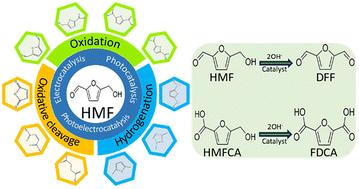光催化、电催化和光电催化选择性氧化 5-羟甲基糠醛的研究进展
IF 9.2
1区 化学
Q1 CHEMISTRY, MULTIDISCIPLINARY
引用次数: 0
摘要
由于现代社会对化石燃料资源的需求日益增长,人们开始关注替代资源。本文首先介绍了 5-羟甲基糠醛(HMF)氧化反应的重要性及其在生物质转化领域的广泛应用。然而,精确控制生物质衍生平台化学品的选择性氧化仍具有挑战性,因此有必要对这一氧化过程的机理进行深入研究。随后,详细讨论了 HMF 氧化反应的机理,包括传统催化剂和新型催化剂的设计和性能优化,旨在为高效和选择性 HMF 氧化提供理论指导和技术支持。在光催化领域,为了提高反应速率和选择性,人们采用了引入光响应催化剂、表面改性和协同催化等策略。在电催化领域,通过调节催化剂结构和活性位点,实现了 HMF 的高效转化。同时,光电催化混合系统作为集光催化和电催化优点于一身的新兴技术,显示出广阔的应用前景,本文概述了其在 HMF 氧化方面的研究。此外,本文还讨论了目前选择性 HMF 氧化所面临的挑战,包括催化剂稳定性、选择性和产物分布等,并提出了未来的研究方向和前景,包括多功能催化剂的设计、反应条件的优化和催化机理的深入探讨等,为实现生物质的高效转化提供了重要参考。综上所述,本文系统总结了选择性光催化、电催化和光电催化在HMF氧化方面的最新研究进展,并对未来发展进行了展望,旨在为相关研究领域提供参考和启示。本文章由计算机程序翻译,如有差异,请以英文原文为准。

Research progress on photocatalytic, electrocatalytic and photoelectrocatalytic selective oxidation of 5-hydroxymethylfurfural
Due to the increasing demand for fossil fuel resources in modern society, attention is turning towards alternative sources. This paper firstly introduces the importance of the oxidation reaction of 5-hydroxymethylfurfural (HMF) and its widespread application in the field of biomass conversion. However, precise control over the selective oxidation of biomass-derived platform chemicals remains challenging, necessitating in-depth investigation into the mechanism of this oxidation process. Subsequently, the mechanism of the HMF oxidation reaction is discussed in detail, including the design and performance optimization of both traditional and novel catalysts, aiming to provide theoretical guidance and technical support for efficient and selective HMF oxidation. In the field of photocatalysis, strategies such as the introduction of photoresponsive catalysts, surface modification, and synergistic catalysis have been employed to enhance reaction rates and selectivity. In electrocatalysis, efficient conversion of HMF has been achieved through the modulation of catalyst structure and active sites. Meanwhile, photoelectrocatalysis hybrid systems, as emerging technologies integrating the advantages of both photocatalysis and electrocatalysis, demonstrate promising application prospects, with an overview of their research in HMF oxidation provided herein. Furthermore, the paper discusses the challenges faced by current selective HMF oxidation, including catalyst stability, selectivity, and product distribution, and proposes future research directions and prospects, including the design of multifunctional catalysts, optimization of reaction conditions, and in-depth exploration of catalytic mechanisms, to provide important references for achieving efficient biomass conversion. In summary, this paper systematically summarizes the latest research progress in selective photocatalysis, electrocatalysis, and photoelectrocatalysis for HMF oxidation, and provides prospects for future development, aiming to offer references and insights for relevant research fields.
求助全文
通过发布文献求助,成功后即可免费获取论文全文。
去求助
来源期刊

Green Chemistry
化学-化学综合
CiteScore
16.10
自引率
7.10%
发文量
677
审稿时长
1.4 months
期刊介绍:
Green Chemistry is a journal that provides a unique forum for the publication of innovative research on the development of alternative green and sustainable technologies. The scope of Green Chemistry is based on the definition proposed by Anastas and Warner (Green Chemistry: Theory and Practice, P T Anastas and J C Warner, Oxford University Press, Oxford, 1998), which defines green chemistry as the utilisation of a set of principles that reduces or eliminates the use or generation of hazardous substances in the design, manufacture and application of chemical products. Green Chemistry aims to reduce the environmental impact of the chemical enterprise by developing a technology base that is inherently non-toxic to living things and the environment. The journal welcomes submissions on all aspects of research relating to this endeavor and publishes original and significant cutting-edge research that is likely to be of wide general appeal. For a work to be published, it must present a significant advance in green chemistry, including a comparison with existing methods and a demonstration of advantages over those methods.
 求助内容:
求助内容: 应助结果提醒方式:
应助结果提醒方式:


